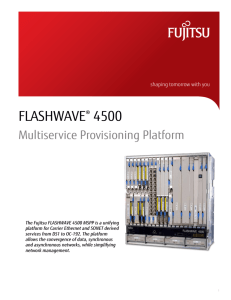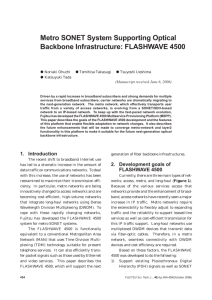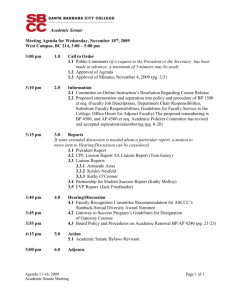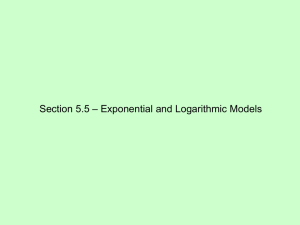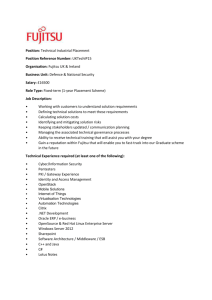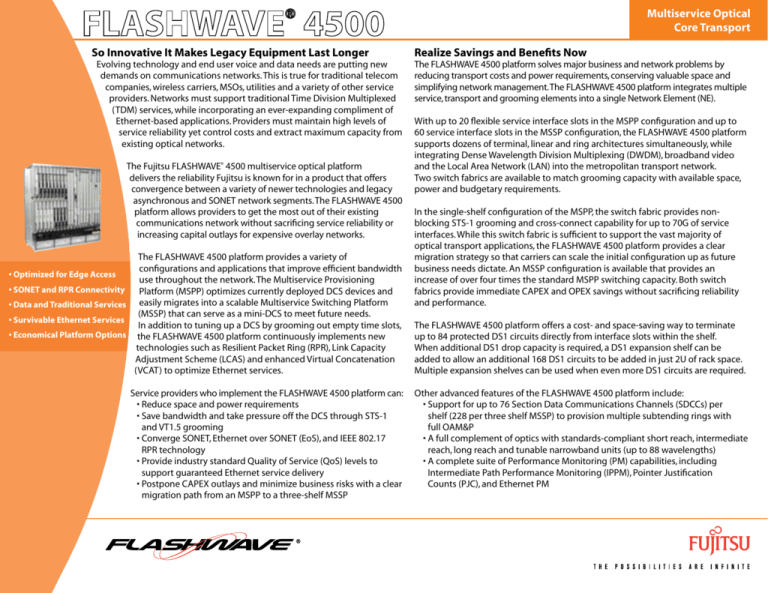
Multiservice Optical
Core Transport
So Innovative It Makes Legacy Equipment Last Longer
Evolving technology and end user voice and data needs are putting new
demands on communications networks. This is true for traditional telecom
companies, wireless carriers, MSOs, utilities and a variety of other service
providers. Networks must support traditional Time Division Multiplexed
(TDM) services, while incorporating an ever-expanding compliment of
Ethernet-based applications. Providers must maintain high levels of
service reliability yet control costs and extract maximum capacity from
existing optical networks.
The Fujitsu FLASHWAVE® 4500 multiservice optical platform
delivers the reliability Fujitsu is known for in a product that offers
convergence between a variety of newer technologies and legacy
asynchronous and SONET network segments. The FLASHWAVE 4500
platform allows providers to get the most out of their existing
communications network without sacrificing service reliability or
increasing capital outlays for expensive overlay networks.
The FLASHWAVE 4500 platform provides a variety of
configurations and applications that improve efficient bandwidth
• Optimized for Edge Access
use throughout the network. The Multiservice Provisioning
• SONET and RPR Connectivity
Platform (MSPP) optimizes currently deployed DCS devices and
• Data and Traditional Services easily migrates into a scalable Multiservice Switching Platform
(MSSP) that can serve as a mini-DCS to meet future needs.
• Survivable Ethernet Services
In addition to tuning up a DCS by grooming out empty time slots,
• Economical Platform Options the FLASHWAVE 4500 platform continuously implements new
technologies such as Resilient Packet Ring (RPR), Link Capacity
Adjustment Scheme (LCAS) and enhanced Virtual Concatenation
(VCAT) to optimize Ethernet services.
Service providers who implement the FLASHWAVE 4500 platform can:
• Reduce space and power requirements
• Save bandwidth and take pressure off the DCS through STS-1
and VT1.5 grooming
• Converge SONET, Ethernet over SONET (EoS), and IEEE 802.17
RPR technology
• Provide industry standard Quality of Service (QoS) levels to
support guaranteed Ethernet service delivery
• Postpone CAPEX outlays and minimize business risks with a clear
migration path from an MSPP to a three-shelf MSSP
Realize Savings and Benefits Now
The FLASHWAVE 4500 platform solves major business and network problems by
reducing transport costs and power requirements, conserving valuable space and
simplifying network management. The FLASHWAVE 4500 platform integrates multiple
service, transport and grooming elements into a single Network Element (NE).
With up to 20 flexible service interface slots in the MSPP configuration and up to
60 service interface slots in the MSSP configuration, the FLASHWAVE 4500 platform
supports dozens of terminal, linear and ring architectures simultaneously, while
integrating Dense Wavelength Division Multiplexing (DWDM), broadband video
and the Local Area Network (LAN) into the metropolitan transport network.
Two switch fabrics are available to match grooming capacity with available space,
power and budgetary requirements.
In the single-shelf configuration of the MSPP, the switch fabric provides nonblocking STS-1 grooming and cross-connect capability for up to 70G of service
interfaces. While this switch fabric is sufficient to support the vast majority of
optical transport applications, the FLASHWAVE 4500 platform provides a clear
migration strategy so that carriers can scale the initial configuration up as future
business needs dictate. An MSSP configuration is available that provides an
increase of over four times the standard MSPP switching capacity. Both switch
fabrics provide immediate CAPEX and OPEX savings without sacrificing reliability
and performance.
The FLASHWAVE 4500 platform offers a cost- and space-saving way to terminate
up to 84 protected DS1 circuits directly from interface slots within the shelf.
When additional DS1 drop capacity is required, a DS1 expansion shelf can be
added to allow an additional 168 DS1 circuits to be added in just 2U of rack space.
Multiple expansion shelves can be used when even more DS1 circuits are required.
Other advanced features of the FLASHWAVE 4500 platform include:
• Support for up to 76 Section Data Communications Channels (SDCCs) per
shelf (228 per three shelf MSSP) to provision multiple subtending rings with
full OAM&P
• A full complement of optics with standards-compliant short reach, intermediate
reach, long reach and tunable narrowband units (up to 88 wavelengths)
• A complete suite of Performance Monitoring (PM) capabilities, including
Intermediate Path Performance Monitoring (IPPM), Pointer Justification
Counts (PJC), and Ethernet PM
Advanced Service Aggregation
TRAFFICD
DEMAN
TRAFFICD
DEMAN
TRAFFICD
DEMAN
TRAFFICD
DEMAN
300G
300G
300G
300G
200G
200G
200G
200G
100G
70G
100G
70G
100G
70G
100G
70G
45G
45G
45G
45G
Service Interface Capacities
Clear Migration Path to Network Optimization
DCS port optimization is one of the key applications for the FLASHWAVE 4500 MSPP/MSSP.
With powerful, centralized 70G/300G STS-1 and 20G VT1.5 switch fabrics, integrated test
access, and full PM capabilities, the FLASHWAVE 4500 platform pre-grooms traffic before
it enters the DCS. The platform optimizes DCS port usage, frees up valuable ports for new
customer traffic and allows carriers to extend the life of an existing DCS.
Optimizing port usage on the DCS can improve its efficiency and delay the purchase of a
new DCS. However, with continued growth, a carrier will eventually need to add another
high-capacity grooming device to the network. Fujitsu provides an elegant solution that
allows grooming capacity to be added as needed, which delays CAPEX and minimizes
risks.
The FLASHWAVE 4500 platform delivers simultaneous transport and grooming through
a centralized STS switching architecture. This switching complex permits any-port-to-anyport connectivity with unequalled flexibility in an optical networking platform.
In addition, VT1.5 switching provides grooming within STS-1s to ensure maximum use of
available bandwidth.
The wide variety of service interfaces available, combined with innovative switching
fabrics capable of handling these services as standard or VCAT SONET entities, allows
grooming and aggregation of disparate signal types such as broadband video, LAN,
asynchronous, and SONET into the metropolitan transport network.
This superior ability to alleviate wasted bandwidth while aggregating services into an
OC-n compatible with any existing SONET network is accompanied by a sophisticated
compliment of innovative features, including:
• Electrical DS1, DS3, EC1 and Ethernet service interfaces, and an additional full
complement of standards-based OC-n optics
• Direct DS1 to OC-192 traffic grooming
• DVB-ASI broadcast video service interfaces for direct digital video transport
over SONET
• Non-blocking VT1.5 and STS grooming plus PM of all transport signals from any port
• Expansive M13 Transmux capabilities
• Multiple architecture support with complete subtending ring, hairpinning and
loopback capabilities
OC-48 IOF
Use a single-shelf FLASHWAVE 4500 MSPP configuration with a 70G STS switch fabric
and 20 interface slots to meet the traffic demands in smaller offices. Later, when traffic
demand grows, the 300G STS switch fabric can be added to allow configurations that
can scale from a single shelf with 20 slots to a full three-shelf configuration that offers
300G of unrestricted STS connectivity with over 60 interface card slots. The threeshelf configuration fits in a single rack. Upgrades from a single-shelf to a multishelf
configuration are non-service-affecting, providing this platform with the easiest
multishelf architecture upgrade available.
A FLASHWAVE 4500 MSPP can be easily expanded to become an MSSP without
losing any interface capacity, SONET/DWDM functionality or support for any
interface type. A triple-stage MSSP system supports a three-fold increase in
interface capacity with 300 Gbps of traffic grooming capacity, all managed
with a single TID, which minimizes any impact on existing operating systems,
procedures and staff.
ADM
OC-48 IOF
DSX-3
ADM
DCS
OC-48/OC-192 IOF
OC-48/OC-192 IOF
MSPP
MSPP
OC-48/OC-192 IOF
MSSP
DCS
Carrier-Class Ethernet with QoS Functionality
Future-Proof Your Network with an Established Solution
Like other members of the FLASHWAVE 4000 series, the FLASHWAVE 4500 platform allows
carriers to leverage their existing SONET investments and still offer advanced, carrierclass, Metro Ethernet Forum (MEF) certified Ethernet transport services. To allow full
convergence in a single NE, the FLASHWAVE 4500 platform uses the inherent granularity
of SONET formatting. Selected bandwidth within the OC-n is optimized for packet traffic
using features such as LCAS and VCAT. Ethernet PM and alarm management are provided
using SONET’s robust overhead. Sub-50 ms ring protection is maintained using UPSR/
BLSR for SONET and steering protection for RPR per IEEE 802.17.
Fujitsu continues to provide the most widely deployed optical transport equipment in the
metro market with more than 320,000 NEs installed across North America. As a trusted
supplier with extensive deployment experience and superior customer service, Fujitsu
helps telecom, MSO, wireless network operators and utility providers to converge their
voice, video and data networks with the FLASHWAVE 4500 platform. The FLASHWAVE 4500
system plays a key role in core, IOF, metro and business access deployments, while
providing an economical link between CATV hub sites, cell towers and long-haul transport
networks.
FLASHWAVE 4500 RPR-based Ethernet services offer low-cost scalability and fast service
activations. The RPR User Network Interfaces (UNIs) allow service bandwidth to be
expanded in increments as small as 1 Mbps without a truck-roll. Automatic topology
discovery capabilities broadcast changes in the RPR network to all nodes without manual
technical intervention. This automation saves OPEX and expedites service activation.
Complemented by the NETSMART® 500 craft user interface and NETSMART 1500 Element
Management System (EMS) software with full Telcordia™ OSMINE compliance and support
for OAM&P, the FLASHWAVE 4500 platform gives you everything you need to build nextgeneration optical networks.
Switching Capacity
FLASHWAVE
RPR Over SONET
4 100
OC-48 Ring
FLASHWAVE
FLASHWAVE
4500
4500
OC-192 Ring
FLASHWAVE
FLASHWAVE
4 5 0 0
FLASHWAVE
4 1 0 0
FLASHWAVE
4100
FLASHWAVE
4100
Specification
OC-48 Ring
Interface Capacity
4500
FLASHWAVE
4500
RPR
Over SONET
FLASHWAVE
4500
FLASHWAVE
4100
FLASHWAVE
4100
Single Stage
MSSP
Double Stage
MSSP
Triple Stage
MSSP
70 Gbps
100 Gbps
200 Gbps
300 Gbps
STS-1
Cross-Connects
1344 x 1344
(70 Gbps)
5760 x 5760
(300 Gbps)
5760 x 5760
(300 Gbps)
5760 x 5760
(300 Gbps)
VT1.5
Cross-Connects
5376 x 5376 10,752 x 10,752 10,752 x 10,752
(10 Gbps)
(20 Gbps)
(20 Gbps)
Single RPR Functionality Over Subtended SONET Rings
RPR is applied during traffic ingress and stripped at egress. While RPR protection operates
independently of SONET protection, switching is implemented whenever the network
is affected by a fiber cut or equipment failure. RPR uses a dual counter-rotating ring
topology (ringlets) and sub-50 ms steering protection to maintain services in the event
of a fiber cut or unit failure. RPR statistical multiplexing with QoS provides additional
bandwidth for sudden fluctuations in demand. This allows service providers to set price
points for various levels of packet-based service quality: guaranteed, partially guaranteed,
and best effort. Demand from higher priority customers is met by borrowing bandwidth
from lower priority users.
MSPP
10,752 x 10,752
(20 Gbps)
Maximum Number of Unprotected (Protected) Service Interfaces
Ports/
Card
MSPP
Single
Stage
MSSP
Double
Stage
MSSP
Triple
Stage
MSSP
DS1 (Integrated)
28
84 (84)
84 (84)
168 (168)
252 (252)
DS1 (High-Density)
168
6720
6720
13,440
20,160
DS3/EC1
8
96 (96)
96 (96)
192 (192)
288 (288)
DS3 Transmux
12
144
144
288
432
OC-3/3c/STM-1
4
80 (40)
80 (40)
160 (80)
240 (120)
OC-12/12c/STM-4
4
80 (40)
80 (40)
160 (80)
240 (120)
OC-48/48c/STM-16
2
40 (20)
40 (20)
80 (40)
120 (60)
OC-192/192c/STM-64
1
4 (2)
10 (5)
20 (10)
30 (15)
10/100Base-T Ethernet
8
80
80
160
240
Gigabit Ethernet
2
40
40
80
120
DVB-ASI
8
40
40
80
120
Type
Multiservice Optical
Core Transport
Features and Specifications
Architectures
Switching
• Terminal
• Linear ADM (1+1)
• Unidirectional Path Switched Ring (UPSR)
• Two Fiber-Bidirectional Line Switched Ring (2F-BLSR)
• Four Fiber-Bidirectional Line Switched Ring (4F-BLSR)
• Dedicated Path Protected Mesh (DPPM)
• Resilient Packet Ring (RPR)
STS Grooming
• MSPP
• MSSP
VT1.5 Grooming
• MSPP
• MSSP
Interfaces
• DS1
1+1 or unprotected
• DS3/EC1
1:n (n=1 to 6) or unprotected
• DS3 Transmux
1+1 or 1:n (n=1 to 6)
• OC-3/STM-1
1+1, UPSR, DPPM or unprotected
• OC-12/STM-4
1+1, UPSR, DPPM or unprotected
• OC-48/STM-161+1, UPSR, 2F-BLSR, DPPM
or unprotected
• OC-192/STM-641+1, UPSR, 2F-BLSR, 4F-BLSR, DPPM
or unprotected
• Ethernet
RPR or unprotected
• DVB-ASI
Unprotected
• Switch matrices
1+1
• Synchronization
1+1
• DS1
64-pin AMP® CHAMP connectors
• DS3/EC1
BNC connectors
•D
S3 Transmux
BNC connectors
• OC-3/STM-1SC for dual unit; LC for quad unit
1310 nm wideband
• OC-12/STM-4LC, FC, SC or ST for single unit;
LC for quad unit
1310 nm wideband
1550 nm wideband (single unit only)
• OC-48/STM-16LC, FC, SC or ST connectors
1310 nm wideband
1550 nm tunable narrowband
(4l @ 50 GHz)
• OC-192/STM-64LC, FC, SC or ST connectors
1310 nm wideband
1550 nm wideband
1550 nm tunable narrowband
(4l @ 100 GHz)
• Ethernet/RPRRJ-45 connectors for
10/100Base-T Ethernet;
LC or SC connectors for Gigabit
Ethernet
• DVB-ASI
BNC connectors
Operations
1344 x 1344 STS-1
5760 x 5760 STS-1
5376 x 5376 VT1.5 (optional)
10,752 x 10,752 VT1.5 (optional)
Protection
Synchronization
• Internal Stratum 3 timing source
• Synchronization Status Messaging (SSM)
• DS1 Building Integrated Timing Supply (BITS) primary
and secondary clock output/input
• Line timing
• In-service expansion from MSPP to MSSP with common
operations benefits
• Standard RPR embedded management plane
• TL1 protocol over X.25, OSI/LCN or IP/LCN
• Simple Network Mentoring Protocol (SNMP)
• TCP/IP and X.25 gateway functionality
• Software download and remote memory backup/restore
• Managed via NETSMART 500 craft user interface and
NETSMART 1500 EMS
• Interoperable with all Fujitsu transmission products
• Telcordia OSMINE compliant
• DS1, DS3, OC-3 and OC-12 test access
• G.709 compliant digital wrapper for narrowband OC-192
optical channel adaptation
• Automatic equipment protection group creation
• PM Threshold Provisioning on a per facility basis
• Full suite of in-service hardware and software upgrades
• NEBS Level 3 compliant
Power Consumption/Heat Dissipation
• Per shelf (typical)
• Power Input
400 W (1364 BTU/hr)
–48 V DC (A and B)
Operating Environment
• Temperature
• Humidity
0 to 50° C (32 to 122° F)
5 to 95% (non-condensing)
Physical Characteristics
• Dimensions (H x W x D)22.8 x 21.5 x 12"
(578 x 546 x 305 mm)
• Weight (fully loaded)
134 lb (61 kg)
Contact your Fujitsu sales representative for more information on how to order this product.
Fujitsu Network Communications Inc.
2801 Telecom Parkway, Richardson, TX 75082
Tel: 800.777.FAST (3278) Fax: 972.479.6900
us.fujitsu.com/telecom
© Copyright 2006 Fujitsu Network Communications Inc. All Rights Reserved.
NETSMART® and FLASHWAVE (and design)® are trademarks of Fujitsu Network Communications Inc. (USA).
FUJITSU (and design)® and THE POSSIBILITIES ARE INFINITE™ are trademarks of Fujitsu Limited.
All other trademarks are the property of their respective owners.
8.0/06.06/CM
Release 9.1

